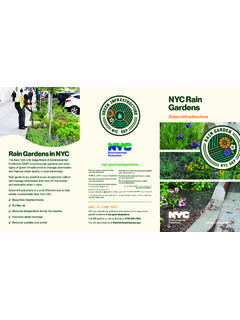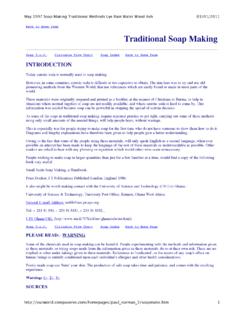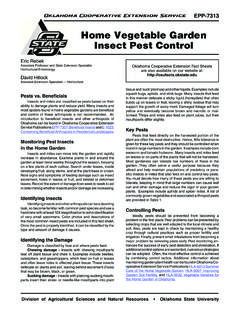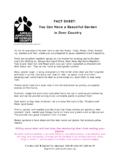Transcription of 2013 Rain Barrel Giveaway Program - New York City
1 2013 rain Barrel Giveaway Program Set-Up Instructions and Helpful Tips This guide contains valuable information that will help you make the most out of your new rain Barrel . Note from the Commissioner Dear Friends: Thank you for participating in the New york city Department of Environmental Protection (DEP) rain Barrel Giveaway Program . The rain Barrel Giveaway Program is part of a citywide effort to reduce stormwater runoff and help conserve water. We hope you find the rain Barrel beneficial. DEP will be conducting a follow-up assessment of rain Barrel use, and your participation is very important. You will receive a short survey during the summer asking about your experience using your new rain Barrel .
2 Your response will help us to better manage this critical Program . Have a wonderful summer! Carter H. Strickland, Jr. Commissioner About the rain Barrel Giveaway Program The rain Barrel Giveaway Program is an important part of our citywide green infrastructure initiative to create a greener, more sustainable city . It began as a pilot Program in 2008 with the distribution of 250 rain barrels to homeowners in the Jamaica Bay watershed. The Program was expanded in 2009 due to the public's overwhelmingly positive response. Green infrastructure systems, including rain barrels, improve New york city 's waterways by using more natural systems to manage runoff during rain storms. Instead of draining into the city 's sewer system, rainwater can be absorbed naturally into the soil at the source.
3 Using a rain Barrel to capture runoff is a great way to both save on your water bill and manage stormwater. During heavy storms, stormwater runoff can overwhelm the city 's sewer system, and in some cases this can cause street flooding. How a rain Barrel Works A rain Barrel captures runoff from your roof and stores it for future activities like watering a lawn or washing a car. The rain Barrel connects directly to your existing downspout so that as soon as the Barrel is full, excess rainwater drains normally into the city 's sewer system. A rain Barrel can collect up to 60 gallons of rainwater at a time, thereby reducing localized street flooding and the demand on the city 's drinking water system during drought conditions.
4 Each Barrel weighs 20 lbs. empty and can weigh up to 500 lbs. when full. Benefits of Using a rain Barrel Saves money. Some households devote almost 40% of their summer water consumption to irrigation needs. Using stored rainwater to water your lawn or garden can reduce your household water usage, which may help save you money on your water bill. Improves harbor water quality. By diverting stormwater from the sewer system during rainy days, a rain Barrel decreases stormwater run-off which carries pollutants from paved surfaces into groundwater and rivers. Keeps your plants healthy. Plants prefer non-chlorinated organic rainwater it is one of the best ways to keep your garden or lawn healthy all summer long.
5 Free car washes. Use stored rainwater to keep your car clean at no cost. Eco-friendly and sustainable. Capturing and using your own rainwater is an easy step towards sustainability, lowers your carbon foot print, and teaches conservation. 2. How to Install the Diverter The diverter kit includes: Diverter Tubing Door 2 x 3 downspout adapter Diverter plugs (2) Hose adapter Self-tapping screws (6) Sealing tape Reducer Step 1: Select the downspout where you want to collect rainwater. Determine the location on the downspout where the diverter will be placed. The diverter should be at least 6 beneath the last turn in the diverter but high enough for the tubing to have a continuous downward slope from the diverter to the rain Barrel .
6 Step 2: Carefully measure and mark where the diverter will be placed on the downspout. Check to see if you have a 3 x 4 or 2 x 3 downspout. Step 3: Using a hacksaw or scissors, cut a section out of the downspout. For 3 x 4 . downspouts, cut out a section. For 2 x 3 downspouts, cut out a section. Protect the exterior wall of your home with cardboard to prevent any damage while cutting. Step 4: Place the diverter into the downspout. For 2 x 3 downspouts, fit the adaptor into the top side of the diverter. The smaller opening is on top exposing two pre-drilled holes for the self tapping screws. Step 5: Attach the self-tapping screws into the pre-drilled holes on the mount tabs where possible. You can also attach the self-tapping screws to the downspout through pre-drilled holes on the sides of the 2 x 3 adaptor or diverter on 3 x 4 opening.
7 Step 6: Attach the tubing to the diverter outlet by plugging the second outlet with the diverter plug. The second hole is for additional rain barrels. Step 7: Screw the hose adapter into the rain Barrel , then attach the reducer to the hose. Push the tubing onto the hose adaptor. Collapse the segments to remove any extra slack. Please note: The bottom of your diverter should nest into the top of the lower portion of the downspout. Before cutting, make sure your downspout will fit. The diverter can be adapted to fit by crimping in the edges of the downspout with needle nose pliers. 3. How to Install the rain Barrel Step 1: Locate the rain Barrel within 4' of the downspout where you attached the diverter.
8 Step 2: Level the ground where the rain Barrel will rest; it must be placed on a level surface. To raise your rain Barrel , it is recommended to use four cinder blocks. An unstable base can result in bodily harm or damage to the rain Barrel . Step 3: Attach the spigot to the rain Barrel . Locate the two washers and the nut on the spigot. Remove the nut and one washer from the spigot and slide the spigot with the remaining washer into the selected hole. Reach into the Barrel and place the second washer over the threaded end of the spigot. Thread the nut on the end of the spigot and tighten by hand. Step 4: Attach the diverter hose adapter by screwing the threaded end into the pre-drilled hole on the top side of the rain Barrel .
9 Step 5: Slide the diverter hose onto the smooth end of the diverter nipple. Please note: You can raise your rain Barrel and attach a hose to the lower port. Please make sure you use a stand that can support 500 lbs. Make sure the support is level. To place your spigot in the lower port, remove the drain plug with a wrench and place the Barrel on its side (use a table or raised flat surface). Insert the spigot into the lower port as stated above in Step 3. 4. How to Winterize Your rain Barrel Follow the steps below before October 15 to properly prepare your rain Barrel for the winter to protect it from cracking in freezing temperatures. Step 1: Remove the spigot and drain the rain Barrel completely.
10 Store all of the parts inside the Barrel so you can easily find them next season. Step 2: Holding the bottom of the downspout diverter, grasp the end of the tubing and gently work the tube back and forth while pulling down until the tubing comes off. Disconnect the tubing on top of the Barrel by gently twisting and pulling the tubing. Step 3: Attach the plug to the tank outlet. One of the diverter's tank outlets or ports will already have a plug on it. Verify that this plug is secure and cannot be pushed any further onto the port. Where the tubing was previously attached, push the diverter plug onto the tank outlet. Gently work the plug back and forth with one hand while holding the diverter in place with the other.
















